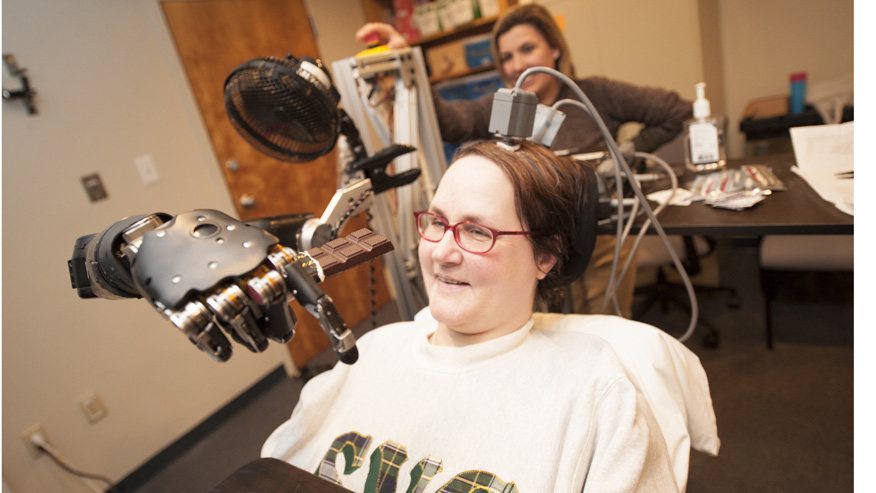
It reads like something out of a sci-fi flick, but new technology created by the Defense Advanced Research Projects Agency (or DARPA) has recently enabled a paralyzed woman to fly an F-35 fighter jet and a single-engine Cessna, in a simulator, using only her mind. Speaking in Washington, DC at the recent New America Foundation’s Future of War forum on February 24th, DARPA Director Arati Prabhakar revealed to the crowd that 55-year-old Jan Scheuermann, who has suffered paralysis since 2003 due to a neuro-degenerative condition, was able to fly a Joint Strike Fighter simulator without the use of any joystick or handheld device.
DARPA researchers have also obtained promising initial results on achieving brain control of an advanced arm system developed by the Johns Hopkins University Applied Physics Lab, the second primary performer on Revolutionizing Prosthetics. This work with tetraplegic volunteers has demonstrated the potential to use advanced prostheses to improve the quality of life for victims of paralysis.
“We now see a future where we can free the brain from the limitations of the human body and I think we can all imagine amazing, good things and amazing, potentially bad things on the other side of that door.” –Arati Prabhakar
#JanScheuermann successfully piloted a F-35 Simulator with just her mind. New #DARPA technology. pic.twitter.com/wrsAXlh0th
— Anon.Dos (@anondos_) March 23, 2015
In 2012, Jan volunteered to undergo surgery and had 2 chips placed on the surface of her brain; specifically on the left hemisphere. Her neuro signals were then picked up, enabling Scheuermann to control a pair of left and right prosthetic arms using only her mind.
Jan was embedded with little anode frameworks containing 96 minor contact chips that would control her right arm and hand development. Each terminal point got signals from an individual neuron, which then handed off to a PC to distinguish the terminating examples connected with specific watched or imagined movements, for example: grabbing a chocolate bar, raising the arm or turning the wrist.
Jan would observe things and envision the automated prosthetic arm movements while a group of specialists recorded the signals that were being sent from her mind.
“She thinks! And she can shake your hand or offer you a stack of cookies. It is an amazing functionality for someone who has been paralyzed for this [amount of] time. However, one day she decided she wanted to fly a Joint Strike Simulator so she got in it and flew the aircraft.” -Arati Prabhakar.
Image Source: Google Image – Jan Scheuermann, who has quadriplegia, brings a chocolate bar to her mouth using a robot arm she is guiding with her thoughts.
When pilots train in a simulator, they need to utilize a joystick to control the plane’s movements, but this was not the case with Jan, all she needed to do was essentially consider guiding the plane and it would move as needs be. DARPA has been working with the University of Pittsburgh Medical Center on the venture and it appears that, at any rate, in this way, “sky’s the limit.”
With respect to whether pilots will soon have the capacity to control physical airplanes with their brains, Prabhakar said there’s a long way to go.
“I think we are a long way from piloting physical jets with mind control, but we have opened this door. You can see some amazing, positive things, but of course we are talking about crossing some major ethical boundaries when you start talking about people being able to utilize this very different way of connecting their brains to the rest of the world. So we think it is an important time to think about what those next steps in research are going to be to engage in a bigger community.” -Arati Prabhakar
Image Source: University of Pierre and Marie CURIE – Jan Scheuermann stacks cones with a mind-controlled robot arm. Research assistant Brian Wodlinger, Ph.D., watches her work.
Despite the fact that ‘brain-controlled physical plane flying’ is a ways in the future, an alternate cool aspect of this innovation, which is straight out of movies like “Star Wars” and “Robocop,” may be here before we know it.
The research Jan was involved in is part of the agency’s ‘Revolutionizing Prosthetics’ program, which is ongoing and aims to continue increasing the functionality of systems so service members with arm loss may, one day, have the option of choosing to return to duty.
This implies that mind-controlled, automated prosthetics could be made available in the near future. Additionally, the dexterous hand capabilities developed under the program have already been applied to small robotic systems used in manipulating un-exploded ordinance, thus keeping soldiers out of situations that have led to limb loss.
SOURCES:






